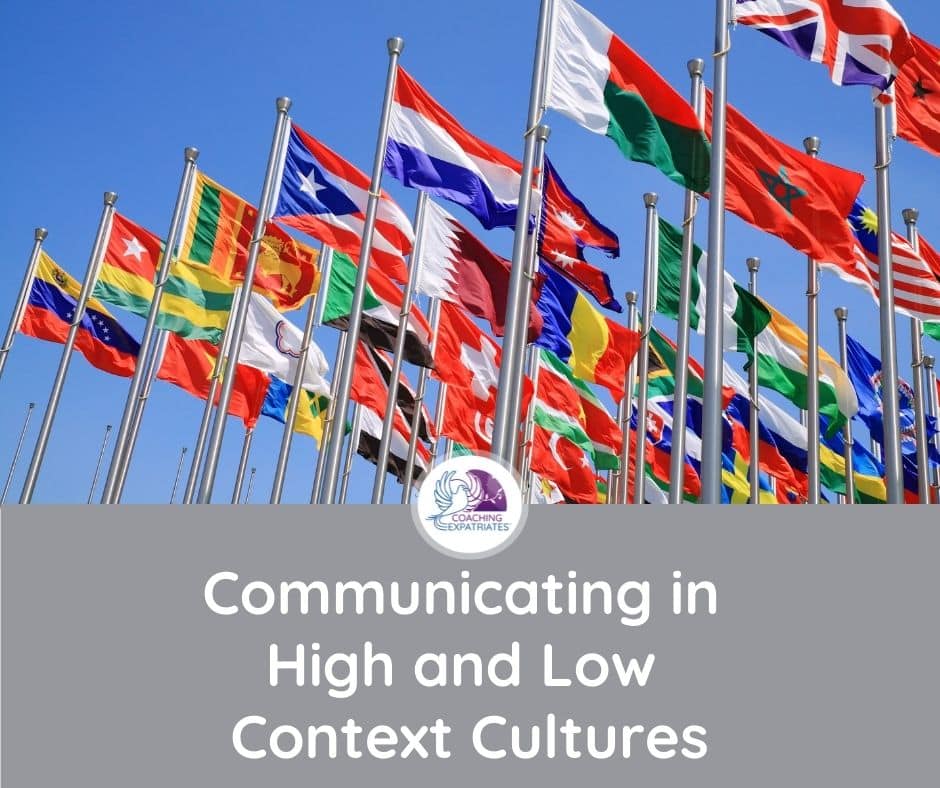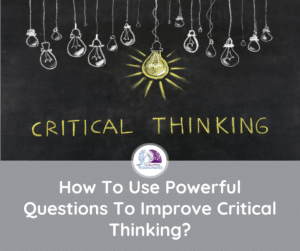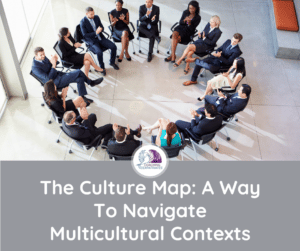Why do we go to meetings in certain countries and spend 5 to 10 minutes chit-chatting at the beginning, while in others, we start straight to the point? Why do some cultures give more importance to punctuality and others not as much? What if I tell you that if global leaders learn the secret to cultural context, their work will be a lot more fun and effective?
In this post, I want to share with you what High and Low Context Cultures are and how this whole concept affects the way people behave, and how we — on the other end — experience them.
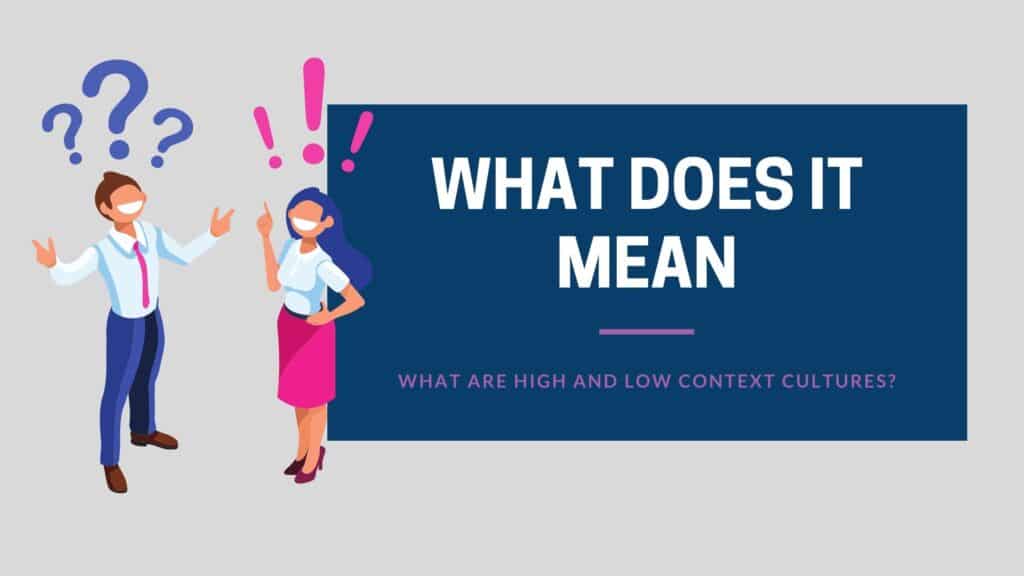
What Are High And Low Context Cultures?
‘High and Low Context cultures’ theory was popularized by Eduard T. Hall in his 1959 book The Silent Language and referred to the idea of how explicit a message is conveyed and/or exchanged in a culture and how important context is in their communication.
The theory of High and Low Context Cultures puts how people communicate in a dimension.
On one side of the dimension, we have high context cultures, which depend on greater context when communicating. They are considered less direct, and they put a lot of weight on gestures and body language to draw significance from messages. They are usually relational and collectivist and give great importance to interpersonal relationships.
The other side of this spectrum is the low context cultures, which depend less on context and prefer greater directness when exchanging messages. They are focused on the message itself and put less weight on additional gestures, context, or environment. They are more focused on the task at hand in the present moment.
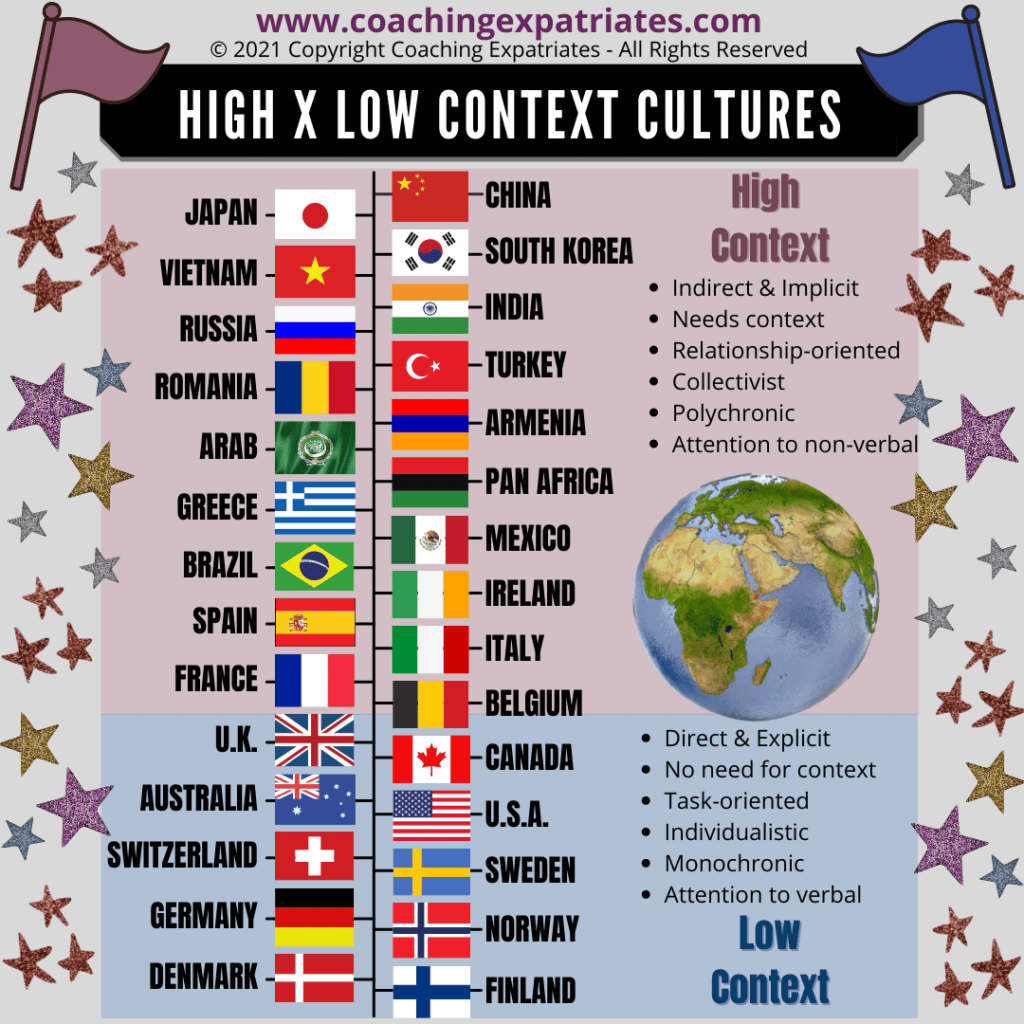
Albert Mehrabian, an Armenian born in 1939, was famous for studying the importance of verbal versus nonverbal communication. His findings were later lead to the creation of the 7-38-55 rule. This rule postulates that we deduce a person’s feelings and thoughts based 7% on what they say (spoken communication), 38% on their voice modulation or tone of voice, and 55% on their body language (non-verbal communication).
Social media later made a widespread claim that this rule is related to how effectively you can communicate; when this is not entirely accurate. If that were so, everybody would actually be part of high-context cultures. The rule is more related to our perception of people and not so much with the communication emphasis.
Of course, we can extrapolate the rule and make sure that we can leverage this knowledge to communicate or negotiate better by being aware that we are perceived based on these proportions.
Mehrabian was extensively researching how we draw conclusions about other people’s thoughts and feelings when communicating. So he was focused on thoughts and feelings perceptions and not communication per se, as I said.
So the bottom line is: when you are communicating feelings or ideas to other people, make sure all 3 points in the rule (verbal, tone, and body language) are consistent so that people can accurately understand what you want to convey instead of feeling confused. We will share an example right below.
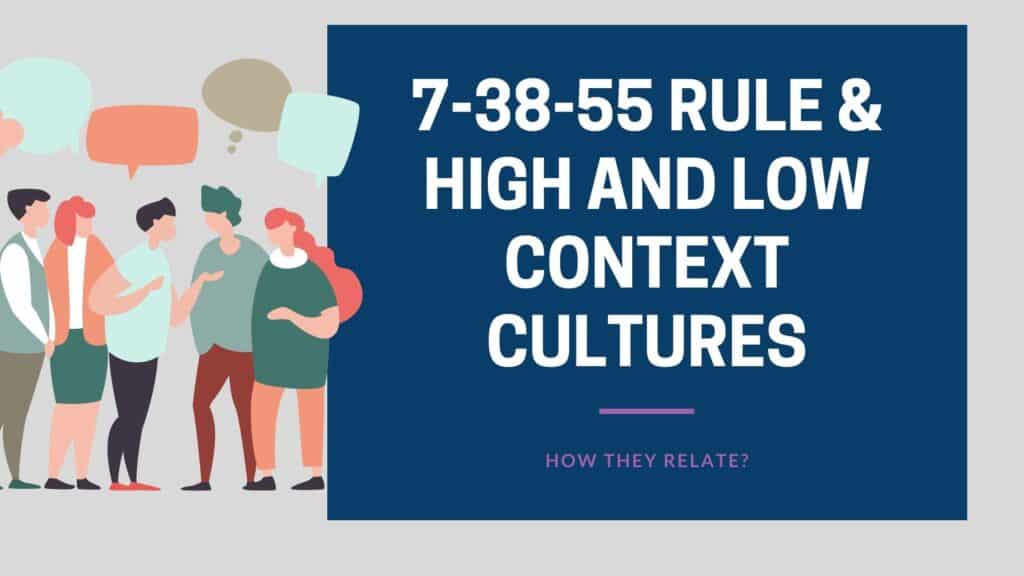
7-38-55 Rule vs High And Low Context Cultures
Here is an example of the connection between the 7-38-55 rule and how it relates to high and low context cultures.
Ana and Amik were discussing who would make the next presentation to an important client. Ana had a clear objection about Amik making the presentation. At some point, Amik clearly asked if Ana had any personal issues with him.
Ana paused for a couple of seconds, then told Amik, “I don’t have any problems with you.” Her arms were crossed, she avoided eye contact, and her body direction was 45° in relation to Amik.
Amik picks up that “there is something off” with her answer, considering her body language and verbal communication were not consistent. And this interpretation came from the 7-38-55 rule. Although she says she does not have a problem, her tone of voice transpires aggression, and her body language is closed.
Now, what does Amik do with this interpretation?
It depends on whether he is in a high or low context culture. If Amik is in a high-context culture, he will not push Ana for more details because he does not want to create conflict. But he will try to gain more clarity about Ana’s behavior through other means so that he can deduce if she is either lying or has just something else in her mind. He will try to dig into context, and find out more about Ana, to decide.
If Amik is in a low-context culture, he will acknowledge that there was something off about Ana’s behavior. However, he will give more weight to what she said and continue to find common ground or solution to that problem. Because low-context cultures depersonalize disagreements, he might even ask why her body language is contradicting what she said.
This example shows that the rule of 7-38-55 provides us with data-points to later make decisions on how to act and further communicate. And this next step’s actions will depend on where we fall in the high and low context culture dimension.

Importance Of Gaining Awareness About High And Low Context Cultures
Since these 2 spectrums are very opposed to each other, interactions between high and low context cultures can cause a lot of frustration and misunderstandings amongst different cultures.

Learning communication skills is an awesome way to become a good leader, but learning how to flex our communication style within the dimensions of high and low context cultures is vital when becoming a global leader.
In the same way that there are different leadership styles, communication styles, and so on, different context preferences also exist. And this is not unique to different countries and cultures.
Jennifer E. Beer makes a good point when mentioning that groups who share context and history tend to become high-context cultures in nature as well. For example, families, high-school friends, college cohorts, departments in corporations, etc. They might live in a low-context culture but might behave more like a high-context culture within that specific community or group.
Learning about high and low context cultures is critical even if you are not a global leader per se. Because, as you can see, it happens in life, so long as we have some sort of affiliation.
One point to note, is that in the next blocks we will share with you the extremes in high and low context cultures. But as I said, this is a dimension. We can be closer to an extreme or anywhere in-between.
Also, as you will see below, there are dimensions within the dimensions. So you might be a very high context in one topic or dimension, and very low in others.
That is why global leaders need to learn all these dimensions and understand that people have different preferences and combinations of tastes. It’s what makes us so unique.
As a global leader, it is our job to be very observant of what these preferences are, and adapt to them, so that we can meet people where they are at. This is the greatest factor for success when engaging cross-culturally and making sure we are inclusive.

How we address high and low context cultures in corporations and make everyone, regardless of their background, feel welcomed, appreciated and respected, is key when driving company culture that is inclusive.
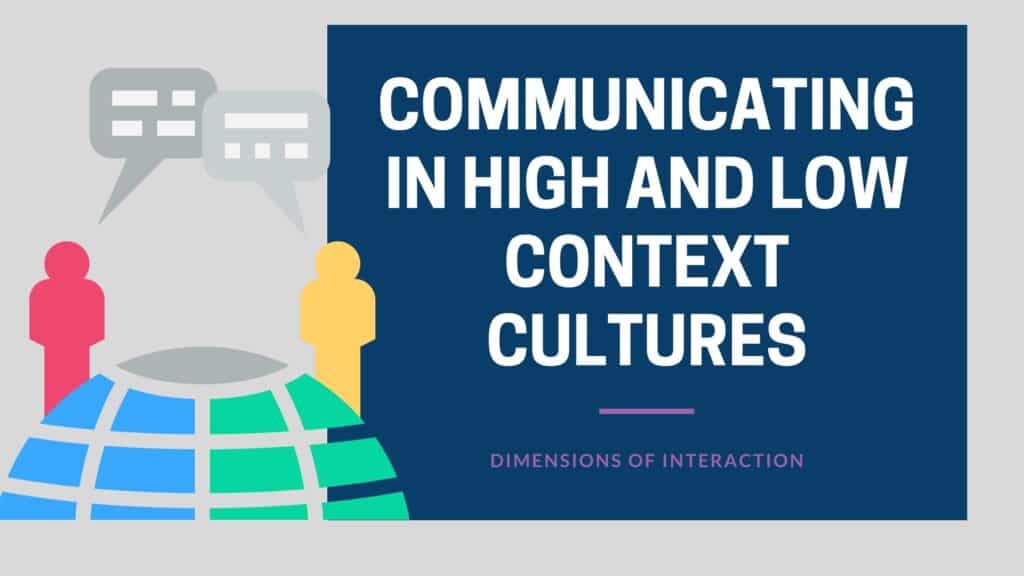
Communicating In High And Low Context Cultures
Because people in high and low context cultures behave, think and operate differently, we also have to communicate differently if we want to reach them precisely.
In this video, I shared 3 things you have to do that are universal and do not depend on high and low context cultures when communicating effectively.
Besides these points, it’s your job to adjust your way of communication to meet the needs of the party or parties you are communicating with. For that, you have to understand each of the dimensions from high and low context cultures.
To make this more didactical, I decided to separate the dimensions between 2:
- Professional Dimensions: dimensions that are engaged when working with that culture,
- Personal Dimensions: dimensions that are engaged with any interaction.
But before we start, let me make a disclaimer: don’t use this information to put people in boxes to judge them quickly. As I said before, we all have a different combination of preferences in each dimension of high and low context culture, and we are unique.
So use this information to gain awareness of the potential differences so that you can spot them quickly – without judgment – and adjust yourself accordingly for increased effectiveness in your interactions.

High And Low Context Cultures: How They Live
In the personal environment, high and low context cultures interact and communicate differently. Let’s talk about the dimensions that affect their personal lives.
To make it easier on you (and me), I will, from now on, use HCC for High-Context Cultures and LCC for Low-Context Cultures.
Relationships & Bonds
For HCC, relationships are precious. That is why they tend to invest in creating strong bonds and long-term relationships. Every opportunity is a good excuse to interact and further deepen the bond. Having many social events and outings is something common in these cultures. However, only a few very strong bonds remain, and they usually relate to shared values or goals. Because of these bonds’ importance, allowing any close relationships to “lose face” is completely prohibited. That can be one of the reasons why LCC can perceive them as less transparent because they might “throw things under the carpet” to protect people from embarrassment.
In contrast, relationships in LCC tend to be more superficial. So they might have more friends and contacts, but the trust and bond levels are lower. And that’s not because they don’t care about people. It’s because their focus is on the task and result, not on people, like with HCC. HCC might perceive them as less loyal people since LCC has no trouble exposing other people’s faults.
Interaction & Communication
There is a great metaphor that explains this dimension well, which is the Iceberg metaphor. It defines things as above the water line – or what is explicit and visible – and what is under the water line – or what is implicit and unseen.
HCC is all about under the waterline. They are indirect and implicit in their interactions, and they focus a lot on what was not spoken. Attention to non-verbal communication is very high. Differently, LCC is all about above the waterline. They are explicit and focus on what’s said, more than what the non-verbal might mean.
HCC is engagement-focused instead of task-focused, so they prioritize things that make the interactions fun and satisfactory for all. This relates to their side of maintaining peace and avoiding conflicts at all costs because – as we said – relationships are more important. On the other hand, LCC is completely task-focused. Their objective is to solve a problem, accomplish a goal, or get some results, so they are not as focused on the engagements.
LCC, differently from HCC, don’t have any trouble discussing conflicts. Actually, they depersonalize any disagreements in favor of completing a task or solving an issue. Of course, they don’t like to get in a fight either, but my point is that they won’t avoid discussing disagreements like in HCC, if that will help get a solution to the task at hand.
Sense of Time
Have you ever heard of Chronemics Studies? It’s a fascinating topic. It studies the role of time in communication and how it applies in different context cultures.
While HCC is polychronic and can do many things simultaneously, LCC is monochronic and gets quickly overwhelmed if things are not done linearly and organized.
Because time is flexible and continuous for HCC, entire schedules can change depending on new events, information, and context. In contrast, LCC has a rigid view of time, and it is compartmentalized. There is a designated time for everything.
One last thing about this topic relates to traditions. HCC highly values traditions, while LCC is much more focused on the present and future.
View of Change
Much in line with the last topic, HCC prefers tradition over change. LCC seeks progress over any tradition, so changes usually happen faster. Change for HCC is perceived as breaking relationships, so they happen very slowly and need a lot of convincing.
When managing change in HCC, people have to be very strategical. Start by convincing highly influential people in the community and putting together an internal campaign, much like we do for commercials. We first create awareness, then we create engagement and desire (consideration), and then we move people into making decisions (conversion). Like with commercials or marketing funnels, managing change in HCC goes through the same process. And because it’s a lengthy process, it can happen a lot slower than in LCC environments.
Knowledge & Learning
The way high and low context cultures acquire knowledge and learn is also different.
In HCC, knowledge is situational, so it depends on how the situation is presenting itself; it is usually implicit and even not fully conscious at times because learning occurs by observing and modeling others. So knowledge is acquired from people. And that is why they use a lot of deductive reasoning.
Differently, in LCC, knowledge is acquired from data and information. So it must be explicit and written for that to happen. Learning therefore occurs by following precise directions and explanations. And that is why from there, they use a lot of inductive thinking or reasoning.
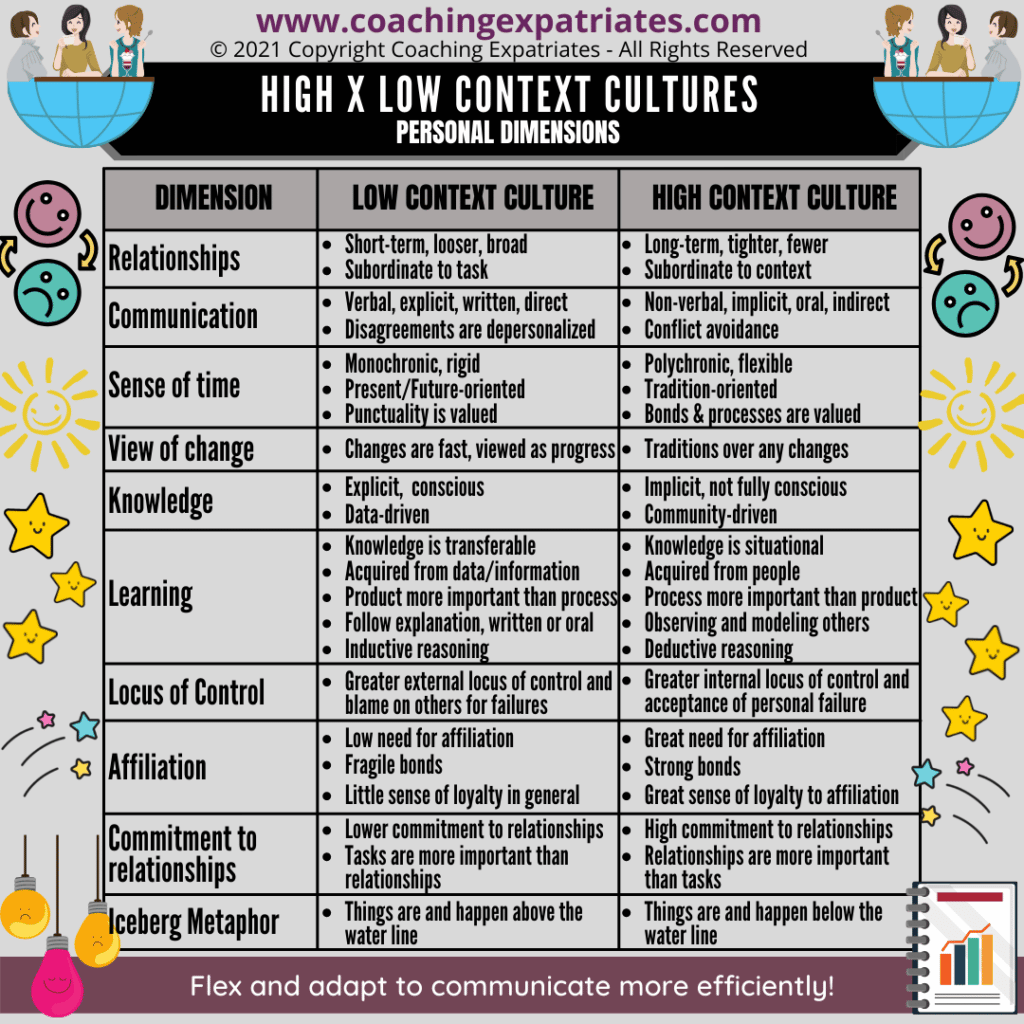
High And Low Context Cultures: How They Work
In the professional environment, as expected, high and low context cultures operate differently as well. Let’s talk about the dimensions that affect their professional lives.
Business Outlook
High-Context cultures don’t like to compete; they are more prone to cooperate and do things together. Competition is seen as a conflict. And because competition implies a loser and a winner, it means peace cannot be maintained, as losers will be unhappy.
If your corporation engages employees in a competition in a HCC, you’ll see people avoiding the initiative or downplaying to maintain peace. The reason is that relationships are precious, and community peace has precedence over any individual achievement.
That is also why you’ll hardly see people bragging in high-context cultures. When talking about achievements, they will often downplay their qualities or attribute achievement to the group.
Because of this characteristic, as a global leader, when interviewing people that come from HCC, you should make extra effort to ask questions that highlight their qualities. When unprepared for an interview, HCC people will not be attractive to the interviewer because they will not have their bragging points handy.
On the other hand, competition is an enjoyable and expected thing in low-context cultures and is perceived as a healthy way of living. It’s perceived as a challenge on not a conflict. Bragging about achievements is usually not an issue in LCC, because individual achievements are expected. Most LCC people have their bragging points handy, and they can wing impromptu interviews reasonably well. They are thought to have their “elevator speech” ready and well-rounded.
In terms of negotiation, the curious thing is that HCC does not perceive it as competition and so is not perceived as a conflict. On the contrary, HCC perceives negotitions as an interpersonal interaction, so they very frequently enjoy engaging in negotiations. That is why in some cultures, not bargaining in a negotiation affair is almost a sign of disrespect – it means you will cut the engagement short. What’s fun in that? And that is why in some cultures, it is so common to take people out for lunch or dinner to discuss negotiations because it extends the engagement.
LCC perceives negotiation engagements a little differently. Because they see it more like a challenge and competition, very often, they enter negotiations with a win-lose mindset. And negotiations are not seen as interpersonal interaction; rather, they are seen as something to be solved and a task to be complete.
Work Style And Ethic
High-context cultures like to work together, so their work style is highly team-oriented. Maintaining the peace of the team or a community is of grave importance for them. Their work processes are less structured than in low context cultures, and they are far more focused on the big picture than on the immediate results. For low context cultures, they will seem very disorganized and chaotic because things happen simultaneously, there might be no agendas in meetings (or they may change last minute), people come and go as they please, and they might even eat during meetings.
On the flip side, low context cultures are task-oriented and work very well alone. Their work processes are usually highly structured. They actually do prefer structure and organized things. They are result-oriented. This means every task and meeting must have a specific objective and a meeting agenda. Punctuality is also essential, and eating in meetings, for some extreme LCC, is a sign of disrespect, as it’s a distraction and not part of the meeting’s objectives.
Decision-Making
The decision-making process in HCC is based on the group’s needs or preferences. In high-context cultures where hierarchies are important, like most Asian cultures, decision-making might be done based on what the highest position in the group thinks is important. In any case, the decision-making process is relational; in other words, it depends on what other people think and want, and not so much on the best solution.
An interesting point worthy of mention is that because a lot of people are involved in decisions in HCC, and many meetings have to happen to get everyone involved, the process of deciding things can be lengthy. Also, when the formal meeting to “make a decision” takes place, the decision was already made. So low-context cultures might feel deceived and frustrated to participate in such meetings.
In contrast, low-context cultures make decisions quite fast, and they involve fewer people in the process. Discussions happen overtly, and there are no side meetings, as this feels like conspiring in their perception. When a decision must be made, they usually notify everyone involved to participate in a scheduled meeting where the actual discussion and decision will be made.
Strategy Planning
When making plans, high context cultures are usually implicit. They don’t see the need for writing things down or even making it too formal. And it makes sense if you consider that when making plans, these cultures usually involve many people. So if everybody already was involved and knows the plan, what’s the point in writing it down or losing time with formalities?
The complete opposite happens in low-context cultures. For them, putting plans on paper, with formal wording, so that it’s documented and organized is critical. And that makes sense in this culture since they appreciate efficacy and result.
Rulership
For high context cultures, relationships have precedence over any rules. This means to say that they follow people’s terms, not any written rules. And if hierarchy plays a big role in that culture, then the highest position determines the rules or terms, including who talks and when.
In contrast, low-context cultures focus on rules over any relationships. Bending the rules for anybody is an act of lack of integrity, in their perspective. And because rules are more important than the people that created them, they don’t care as much about hierarchy. The egalitarian ruling makes more sense since the rules are plain, written, and formal.
Territoriality
This is usually the first thing that clashes when high and low context cultures meet for the first time. High context does not need a lot of personal space since, from their perspective, space is communal. They also touch others a lot as a sign of acceptance and liking. And context has precedence over privacy.
So, low context cultures might see high context cultures as nosy or inquisitive. And very often, they can feel harassed with all the touching. For them, personal space is crucial, and privacy is extremely important. And it makes sense, as they don’t need as much context, so why sharing their privacy? They also prefer designated space for things with ownership attribution. “My cubicle” or “my side of the table.”
Productivity
High-context cultures prefer to receive a task with a general idea of what to do. They like the freedom to do things in their own order and timing. Therefore, when receiving a task, they don’t want the task’s details; instead, they want its context. Why is that needed, who is asking that for, who will benefit, how will this impact the department, and so on.
Conversely, low context cultures prefer to receive specific and detailed instructions about tasks while not caring as much for the context. They are focused on the task itself and the results needed.
High-context cultures use breaks to interact with other people and chat, while low-context cultures will use it for personal time or get personal tasks done. So in breaks, LCC wants privacy, while HCC wants connection.
Lastly, LCC tends to value punctuality a lot, and they schedule their events with formal meetings and interactions. They also tend to do one thing at a time since their sense of time is monochronic.
On the other hand, HCC values relationships above anything else, so if a chat takes longer and they become 10 minutes late for a meeting, people are usually more understanding. A lot of “meetings” happen informally for HCC, either in a Starbucks or a restaurant. Their view of time is polychronic, so they actually have fun mixing and doing a bunch of things at once. And very often, a formal meeting might end up in a restaurant anyways, and they will continue the “meeting” there. Which might aggravate LCC, who sees these outings as personal and private and not for mixing with business.
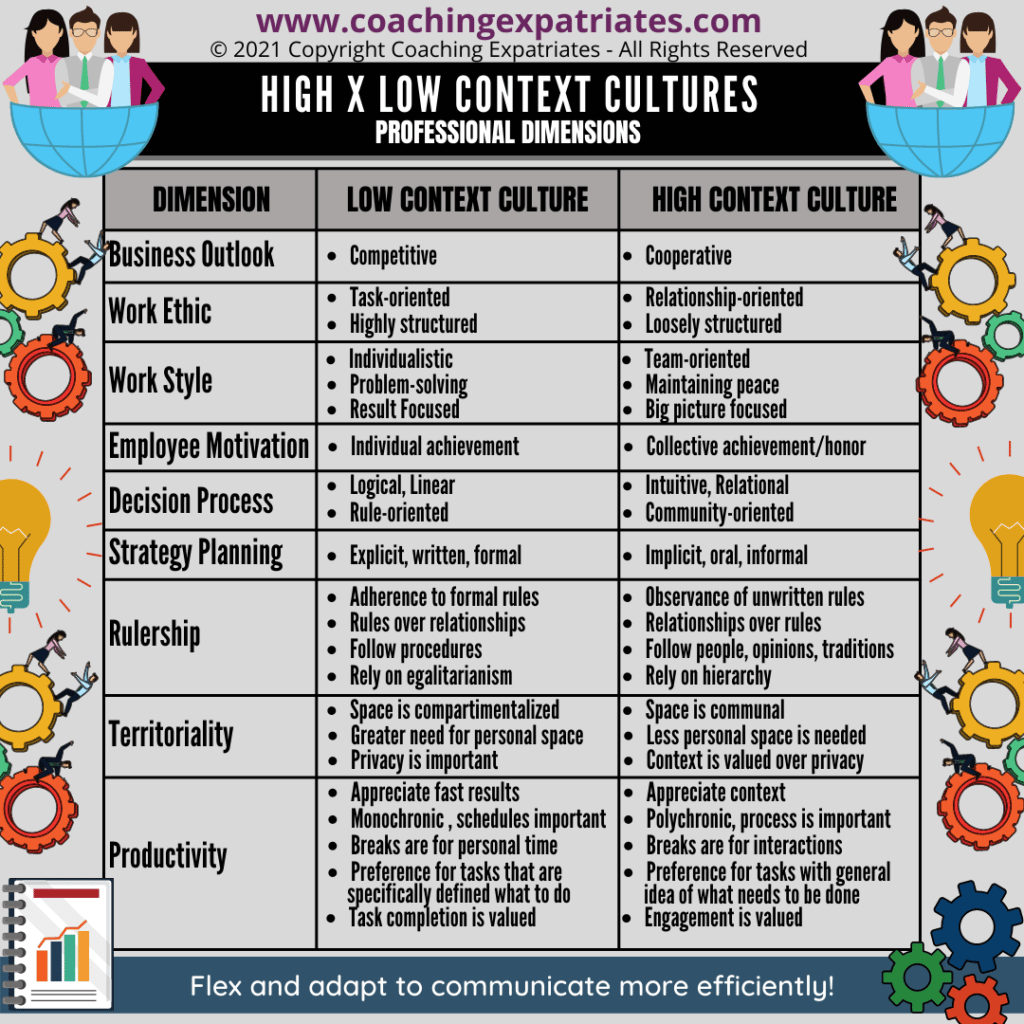

High And Low Context Cultures: Examples
Let’s review some examples from high and low context cultures. This way, you’ll start to connect the different dimensions that we just spoke about above to real cases.
Read the cases below and based on what you read, think if it’s a low context culture example or a high context culture example.
Low or High?
Correct! High-context communicators tailor their speech toward who they’re talking to and how they fit into relationships with those people.
Correct! Low-context communicators value their private time a lot. They either want to use it for personal matters or to get some rest.
Correct! High-context communicators focus on maintaining peace and will be more indirect when communicating a negative message.
Correct! Low-context communicators need personal space and will not touch other people without their explicit permission. Trespassing personal space and touching without permission is an act of aggression or intrusion, even if unconsciously.
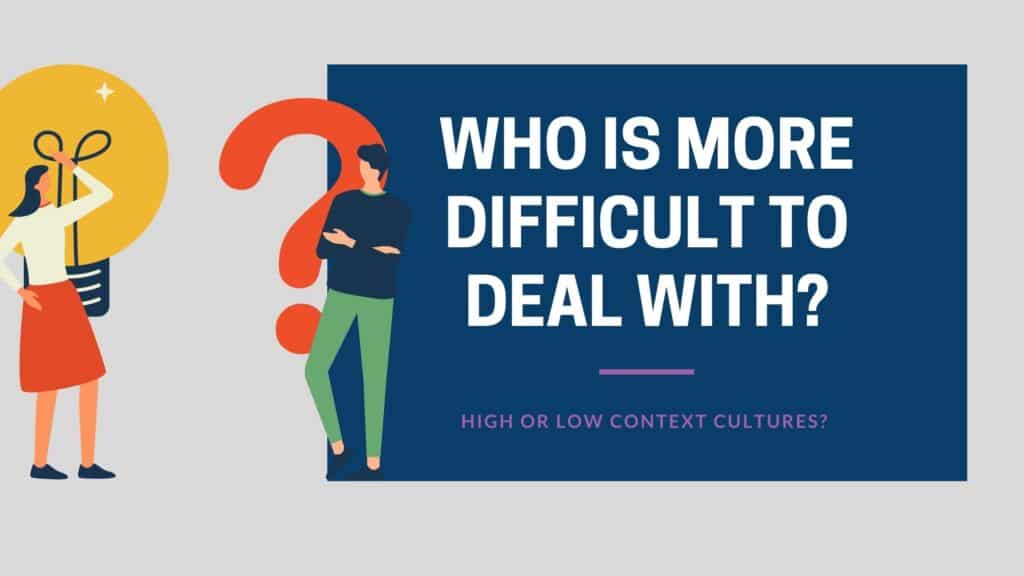
High And Low Context Cultures: Who Is More Difficult To Deal With?
After reading all this content, I have a question for you. When do you think about high and low context cultures, who do you think is more challenging to deal with? Extremes or middle?
This is a matter of opinion. So I will share my personal opinion on this, which might or might not resonate with you.
Cultures that fall closer to the middle of the dimension of high and low context cultures are called Multi-Active Cultures, and this denomination comes from another’s guy concepts – Richard Lewis – who also studied different cultures to understand behavior.
People and cultures that fall more in the middle are far more difficult to understand if we compare that with extremes, in my personal opening.
And my reasoning for that is simple. Extremes are easy to spot and know. All the knobs & dimensions mentioned above are on the extremes. Multi-active cultures, though, have knobs all over the place. The combination of high and low can be very confusing and difficult to spot, and it needs time and immersion in that culture to figure them out.
For example, Americans are straightforward, but they enjoy the social engagement and chatting, so long as it does not extend for too long. How much is too long?
And that’s what I meant at the beginning of our post: each culture is unique, and each of us is unique within each culture. Our job as global leaders is to learn the dimensions within high and low context cultures and map people’s interests and preferences to meet them where they are at.
Oh, and one more thing: it is important to note that no culture is “better” than another; communication styles simply convey differences, rather than superiority. So make sure you don’t have any (conscious or unconscious) bias around that!

How To Learn More About Global Leadership?
OPTION 1: Global Executive Leadership Program
If you are interested in learning more about the 4 secret pillars of success in Global Leadership, which includes the topic of high and low context cultures, don’t miss our 9-week Global Executive Leadership Program. It covers all aspects of the 4 pillars, in a very transformational and interactive self-paced online course.
It’s not meant for any leader. It’s intended for those who want to be impactful, influential, and inclusive global leaders. It’s for those who want to learn how to communicate more effectively with different types of leaders and cultures. You can learn all the skills in each of the 4 pillars in one single place without any hassle. Subscribe to get more information on the program, and you’ll be notified once it’s
OPTION 2: How To Become A 3i Global Leader – Free Webinar
If you seek a quick training that talks about some examples and experiences in each of the 4 leadership areas to illustrate them, stay tuned for our on demand webinar. It’s a 90 minutes webinar packed with information on the 4 secret pillars of global leadership success and how to become a 3i global leader (impactful, influential, inclusive). Subscribe to our newsletter below if you also want to receive weekly content on global leadership.
OPTION 3: Global Leadership Competencies – Coaching Program
On top of this, we also offer executive coaching programs for busy professionals. Contact us if you want to improve a specific skill in any of the 4 pillars or work on many skills at once. We can customize a program just for you. Or, conversely, you can follow our regular program, where we will talk about one of the competencies each week during a longer program.
If you enjoyed this post, consider subscribing to our newsletter. We cover global leadership tips, habit and decision-making hacks, and cultural competence topics for global leaders who want to be impactful, influential, and inclusive. Or the “3i” Global Leader. We know your inbox is sacred, so we write only once per week, and we never share your information. If you think this might be positive for your career, use the form below to subscribe.

